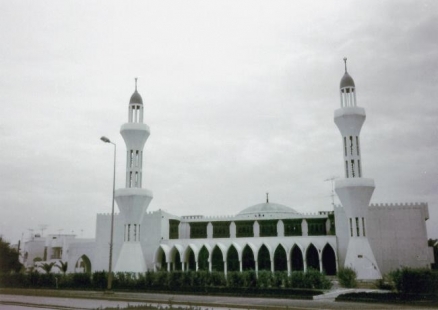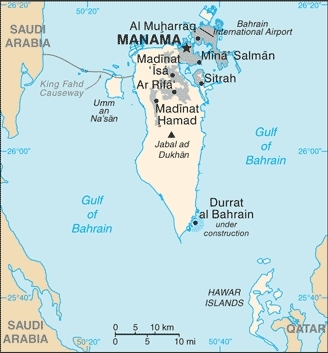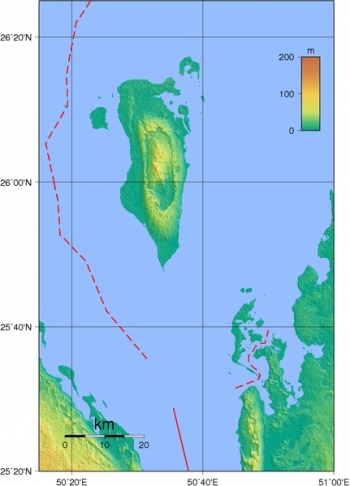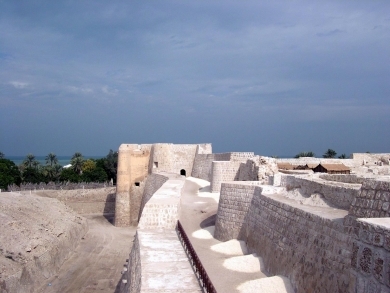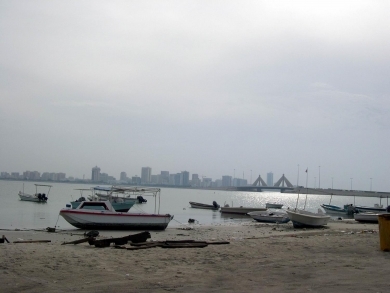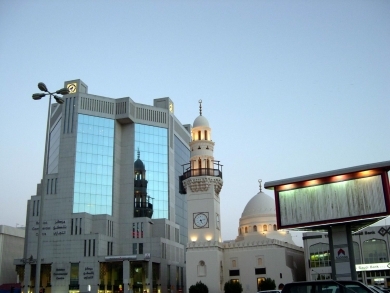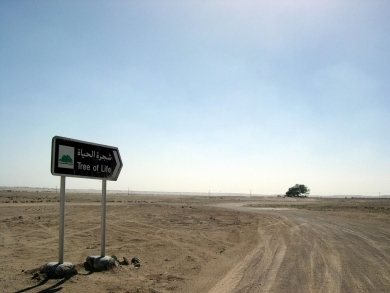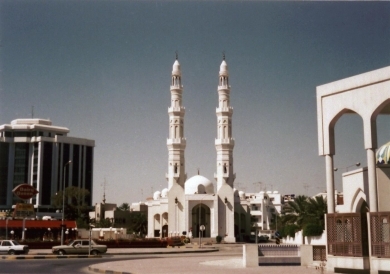Bahrain (About the EoE)
Contents
Bahrain
Countries and Regions of the World Collection  Bahrain is a small nation of 1.2 million people composed of an archipelago in the Persian Gulf east of Saudi Arabia.
Bahrain is a small nation of 1.2 million people composed of an archipelago in the Persian Gulf east of Saudi Arabia.
Its major environmental issues include:
- desertification resulting from the degradation of limited arable land, periods of drought, and dust storms;
- coastal degradation (damage to coastlines, coral reefs, and sea vegetation) resulting from oil spills and other discharges from large tankers, oil refineries, and distribution stations; and,
- lack of freshwater resources (groundwater and seawater are the only sources for all water needs).
Bahrain is susceptible to periodic droughts and dust storms.
Bahrain is close to primary Middle Eastern petroleum sources with a strategic location in the Persian Gulf, through which much of the Western world's petroleum must transit to reach open ocean
In 1783, the Sunni Al-Khalifa family captured Bahrain from the Persians. In order to secure these holdings, it entered into a series of treaties with the United Kingdom during the 19th century that made Bahrain a British protectorate.
The archipelago attained its independence in 1971. Facing declining oil reserves, Bahrain has turned to petroleum processing and refining and has transformed itself into an international banking center.
Since achieving independence in 1971, Bahrain has pursued a policy of close consultation with neighboring states. Bahrain became a member of the United Nations and the Arab League in 1971. In 1981 it joined its five neighbors -- Saudi Arabia, Oman, Kuwait, the U.A.E., and Qatar--to form the strategic Gulf Cooperation Council (GCC). Bahrain has complied with GCC efforts to coordinate economic development and defense and security planning. In December 1994, for example, Bahrain concurred with the GCC decision to drop secondary and tertiary boycotts against Israel. Bahrain also responded positively to Kuwait's request to deploy the GCC collective defense Peninsula Shield Force during the buildup and execution of Operation Iraqi Freedom (OIF) in 2003.
Bahrain's small size and central location among Persian Gulf countries require it to play a delicate balancing act in foreign affairs among its larger neighbors. In addition, the Sunni-led government has struggled to manage relations with its approximately 70% Shia-majority population.
During the mid-to-late 1990s, Shia activists mounted a low-intensity uprising to demand that the Sunni-led government stop systemic economic, social, and political discrimination against Shia Bahrainis.
King Hamad bin Isa Al-Khalifa, after succeeding his late father in 1999, pushed economic and political reforms in part to improve relations with the Shia community.
After boycotting the country's first round of democratic elections under the newly-promulgated constitution in 2002, Shia political societies participated in 2006 and 2010 in legislative and municipal elections and Wifaq, the largest Shia political society, won the largest bloc of seats in the elected lower-house of the legislature both times. Nevertheless, Shia discontent persisted, often manifesting itself in street demonstrations and occasional low-level violence. (see History below for recent developments)
Geography
Location: Middle East, archipelago in the Persian Gulf, east of Saudi Arabia
Geographic Coordinates: 26 00 N, 50 33 E
Area: 760 sq km (land: 760 sq km; water: 0 sq km)
Coastline: 161 km
Maritime Claims:
territorial sea: 12 nm
contiguous zone: 24 nm
continental shelf: extending to boundaries to be determined
Natural Hazards: periodic droughts; dust storms
Terrain: mostly low desert plain rising gently to low central escarpment. The highest point is Jabal ad (Dukhan 122 m) and the lowest point is the Persian Gulf (0 m).
Climate: arid; mild, pleasant winters; very hot, humid summers.
Ecology and Biodiversity
Ecologically, Bahrain is part of the Persian Gulf desert and semi-desert ecoregion which comprises part of the Eastern Province of Saudi Arabia, including its entire coastline along the Arabian Gulf, as well as Bahrain island, the coastline of Qatar and a small stretch of coastline belonging to the Abu Dhabi emirate of the United Arab Emirates (UAE). In the north, much of Kuwait is included. An inland finger projects south from Kuwait towards the great sand desert that dominates all of southern Arabia, the Rub'al-Khali. The area serves as an important stop for birds migrating from Asia to wintering spots in Africa, and over 250 species of birds have been recorded. Threats to this ecoregion include feral rodents that disrupt the bird population, oil spills, overgrazing, and wildlife poaching.
In Qatar and Bahrain terrestrial wildlife species diversity is low and there are few, if any, endemics. Most of Qatar, with its flat desert and scanty vegetation, supports only a sparse and restricted avifauna. Of 255 species recorded in the country, about 23 breed there, 78 are winter visitors and 104 are regular migrants. Bahrain was believed to be connected to the mainland of Arabia until 6,000 B.C. and its subsequent separation is cited as a reason for the low diversity of mammalian fauna.
The coastal zone with its intertidal mudflats and offshore islands is important for breeding sea birds and other migrating species, particularly as Saudi Arabia offers a land bridge connecting Africa with Eurasia. One site at Tarut Bay is considered to be the most important site on the Saudi Arabian Gulf Coast for wintering and migrating waders and other water birds, with a total of c. 58,000 waterbirds in 1991/92, and more than 20,000 present in April-May 1991. The houbara bustard (Chlamydotis undulata), a globally threatened species, occurs regularly in Bahrain as a passage migrant in autumn and a rare winter visitor to the open desert in the south of the island.
On Bahrain island, the Environmental Protection Committee is the government body responsible for environmental matters and protected areas for nature conservation. Al-Areen Wildlife Reserve on Bahrain island, established in 1976, was built as a sanctuary to conserve vegetation and also functions as a wildlife captive-breeding centre.
The entire 1,200 kilometers (km) coastline of this ecoregion is vulnerable to major oil spills . Hill indicates that Phalacrocorax nigrogularis is one of the most commonly found oiled dead birds around the Bahrain coastline. Overgrazing by camels, goats and sheep is a common threat to the area's vegetation. The mangroves are under pressure in some areas from overgrazing by camels. Disturbance from fisherman, recreational campers and divers, and the military is a threat along various coastal stretches and islands. However, in some areas the military has fenced off certain sites, protecting the vegetation and eliminating grazing pressure. Feral mice are reported to be a threat, particularly when their population peaks coincide with the tern breeding season on Saudi Arabia's Gulf Coral Islands. Land reclamation and dredging poses a threat to various sites on Bahrain island.
See: Persian Gulf desert and semi-desert
People and Society
Bahrain is one of the most densely populated countries in the world; about 89% of the population lives in the two principal cities of Manama and Al Muharraq. Approximately 66% of the indigenous population is originally from the Arabian Peninsula and Iran. Bahrain has a sizeable foreign labor force. The government's policies on naturalization remain controversial. In June 2002, the King issued a decree allowing citizens of the Gulf Cooperation Council (GCC) to take up dual Bahraini nationality. Opposition political groups charge that the government is granting citizenship to foreign nationals who have served in the Bahraini armed forces and security services to alter the demographic balance of the country, which is primarily Shi'a. According to passport officials, about 40,000 individuals have been naturalized over the past 50 years.
The indigenous population is 98% Muslim. Although some two-thirds of the indigenous population is Shi'a Muslim, the ruling family and the majority of government, military, and corporate leaders are Sunni Muslims. The small indigenous Christian and Jewish communities make up the remaining 2% of the population. Roughly half of foreign resident community are non-Muslim, and include Christians, Hindus, Baha'is, Buddhists and Sikhs.
Population: 1,248,348 includes 235,108 non-nationals (July 2012 est.)
| Walls of the historic Qal'at al-Bahrain (Fortress of Bahrain), which is the largest and most ancient historical site in the country. It was an important center of the Dilmun Civilization (2nd and 1st millennia B.C.); in later periods, it served as a trading and military outpost. |
| Manama, the capital of Bahrain, seen from a distance. Its wealth is based on financial services, petroleum, ship repair, and tourism; one of its shopping malls, the Seef (Souk), has luxury apartments and five-star hotels. |
| Downtown Manama is a shopper's paradise. |
| The Tree of Life is one of Bahrain's major tourist destinations; it is located in the middle of the desert and somehow has survived for hundreds of years with no obvious source of water. |
| Mosque near Delmun Roundabout in Manama. |
Age Structure:
0-14 years: 20.5% (male 126,313/female 122,359)
15-64 years: 77% (male 595,244/female 339,635)
65 years and over: 2.6% (male 14,791/female 16,363) (2011 est.)
Population Growth Rate: 2.652% (2012 est.)
Birthrate: 14.41 births/1,000 population (2012 est.)
Death Rate: 2.63 deaths/1,000 population (July 2012 est.)
Net Migration Rate: 14.74 migrant(s)/1,000 population (2012 est.)
Life Expectancy at Birth: 78.29 years
male: 76.16 years
female: 80.48 years (2012 est.)
Total Fertility Rate: 1.86 children born/woman (2012 est.)
Languages: Arabic (official), English, Farsi, Urdu
Literacy (age 15 and over can read and write): 86.5%
Education: Bahrain has invested its oil revenues in developing an advanced educational system. The first public schools for girls and boys were opened in the 1920s. The government continues to pay for all schooling costs. Although school attendance is not compulsory, primary and secondary attendance rates are high, and literacy rates are currently among the highest in the region. Higher education is available for secondary school graduates at the Bahrain University, Arabian Gulf University and specialized institutes including the College of Health Sciences -- operating under the direction of the Ministry of Health -- which trains physicians, nurses, pharmacists, and paramedics. The government has identified providing educational services to the Gulf Cooperation Council as a potential economic growth area, and is actively working to establish Bahrain as a regional center for higher education.
Urbanization: 89% of total population (2010) growing at an annual rate of change of 1.8% (2010-15 est.)
History
The site of the ancient Bronze Age civilization of Dilmun, Bahrain was an important center linking trade routes between Mesopotamia and the Indus Valley as early as 5,000 years ago. The Dilmun civilization began to decline about 2,000 B.C. as trade from India was cut off. From 750 B.C. on, Assyrian kings repeatedly claimed sovereignty over the islands. Shortly after 600 B.C., Dilmun was formally incorporated into the new Babylonian empire. There are no historical references to Bahrain until Alexander the Great's arrival in the Gulf in the 4th century B.C. Although Bahrain was ruled variously by the Arab tribes of Bani Wa'el and Persian governors, Bahrain continued to be known by its Greek name Tylos until the 7th century, when many of its inhabitants converted to Islam. A regional pearling and trade center, Bahrain came under the control of the Ummayad Caliphs of Syria, the Abbasid Caliphs of Baghdad, Persian, Omani and Portuguese forces at various times from the 7th century until the Al Khalifa family, a branch of the Bani Utbah tribe that have ruled Bahrain since the 18th century, succeeded in capturing Bahrain from a Persian garrison controlling the islands in 1783.
In the 1830s the Al Khalifa family signed the first of many treaties establishing Bahrain as a British Protectorate. Similar to the binding treaties of protection entered into by other Persian Gulf principalities, the agreements entered into by the Al Khalifas prohibited them from disposing of territory and entering into relationships with any foreign government without British consent in exchange for British protection against the threat of military attack from Ottoman Turkey. The main British naval base in the region was moved to Bahrain in 1935 shortly after the start of large-scale oil production.
In 1968, when the British Government announced its decision (reaffirmed in March 1971) to end the treaty relationships with the Persian Gulf sheikdoms, Bahrain initially joined the other eight states (Qatar and the seven Trucial Sheikhdoms now the United Arab Emirates) under British protection in an effort to form a union of Arab emirates. The nine sheikhdoms still had not agreed on terms of union by 1971, however, prompting Bahrain to declare itself fully independent on August 15, 1971.
Bahrain promulgated a constitution and elected its first parliament in 1973, but just 2 years later, in August 1975, the Amir disbanded the National Assembly after it attempted to legislate the end of Al-Khalifa rule and the expulsion of the U.S. Navy from Bahrain.
Since achieving independence in 1971, Bahrain has pursued a policy of close consultation with neighboring states. Bahrain became a member of the United Nations and the Arab League in 1971. In 1981 it joined its five neighbors -- Saudi Arabia, Oman, Kuwait, the U.A.E., and Qatar--to form the strategic Gulf Cooperation Council (GCC). Bahrain has complied with GCC efforts to coordinate economic development and defense and security planning. In December 1994, for example, Bahrain concurred with the GCC decision to drop secondary and tertiary boycotts against Israel. Bahrain also responded positively to Kuwait's request to deploy the GCC collective defense Peninsula Shield Force during the buildup and execution of Operation Iraqi Freedom (OIF) in 2003.
In addition to maintaining strong relations with its largest financial backers, Saudi Arabia, Kuwait, and the U.A.E., Bahrain has worked to improve its relations with Qatar and has proper, but not warm, relations with Iran. Bahrain-Iran relations have been strained since the discovery in 1981 of an Iran-sponsored coup plot in Bahrain. Bahraini suspicions of the Iranian role in local unrest in the mid-1990s remain. On March 16, 2001, the International Court of Justice (ICJ) announced its judgment on the long-standing maritime delimitation and territorial dispute between Bahrain and Qatar. The binding judgment awarded sovereignty over the Hawar Islands and Qit'at Jaradah to Bahrain and sovereignty over Zubarah (part of the Qatar Peninsula), Janan Island, and Fasht ad Dibal to Qatar. The peaceful settlement of this dispute has allowed for renewed co-operation, including plans to construct a causeway between the two countries.
In the 1990s, Bahrain suffered from repeated incidents of political violence stemming from the disaffection of the Shi'a majority. In response, the Amir instituted the first Bahraini cabinet change in 20 years in 1995 and also increased the membership of the Consultative Council, which he had created in 1993 to provide advice and opinion on legislation proposed by the cabinet and, in certain cases, suggest new laws on its own, from 30 to 40 the following year. These steps led to an initial decline in violent incidents, but in early 1996 a number of hotels and restaurants were bombed, resulting in several fatalities. Over 1,000 people were arrested and held in detention without trial in connection with these disturbances. The government has since released these individuals.
Shaikh Hamad bin Isa Al Khalifa acceded to the throne in March 1999, after the death of his father Shaikh Isa bin Hamad Al Khalifa, Bahrain's ruler since 1961. He championed a program of democratic reform shortly after his accession. In November 2000, Shaikh Hamad established a committee to create a blueprint to transform Bahrain from a hereditary emirate to a constitutional monarchy within 2 years. The resulting "National Action Charter" was presented to the Bahraini public in a referendum in February 2001. In the first comprehensive public vote in Bahrain since the 1970s, 94.8% of voters overwhelmingly endorsed the charter. That same month, Shaikh Hamad pardoned all political prisoners and detainees, including those who had been imprisoned, exiled or detained on security charges. He also abolished the State Security Law and the State Security Court, which had permitted the government to detain individuals without trial for up to 3 years.
On February 14, 2002, 1 year after the referendum endorsing his National Action Charter, Shaikh Hamad pronounced Bahrain a constitutional monarchy and changed his status from Amir to King. He simultaneously announced that the first municipal elections since 1957 would be held in May 2002, and that a bicameral parliament, with a representative lower house, would be reconstituted with parliamentary elections in October 2002. As part of these constitutional reforms, the government created an independent financial watchdog empowered to investigate cases of embezzlement and violations of state expenditure in July 2002.
Turnout for the May 2002 municipal elections was 51%, with female voters making up 52% of voters. Turnout for the 2002 parliamentary elections -- the first in almost 3 decades -- was 53% in the first round and 43% in the second round, despite the fact that four political societies, including the largest Shi'a society, organized a boycott to protest constitutional provisions enacted by the King that gave the appointed upper chamber of parliament voting rights equal to the elected lower chamber. The new parliament held its first joint sitting in December 2002. Bahrain held its second set of parliamentary and municipal elections in November and December 2006. All registered political societies participated in the elections and a Shi'a society, Al Wifaq, represented the largest single bloc inside the Council of Representatives. Thirty-two of the Council's 40 members represented Sunni and Shi'a Islamist societies. One woman, Lateefah Al-Qauod, ran uncontested and became the first woman elected to parliament in Bahrain. Parliamentary and municipal elections were held again in 2010.
Bahrain's strategic partnership with the U.S. has intensified since 1991. Bahraini pilots flew strikes in Iraq during the 1991 Gulf War, and the country was used as a base for military operations in the Gulf. Bahrain provided logistical and basing support to international maritime interdiction efforts to enforce UN sanctions and prevent illegal smuggling of oil from Iraq in the 1990s. Bahrain also provided extensive basing and overflight clearances for a multitude of U.S. aircraft operating in support of Operation Enduring Freedom (OEF) and Operation Iraqi Freedom (OIF). Bahrain deployed forces in support of coalition operations during both OEF and OIF and participates in the International Security Assistance Force (ISAF) in Afghanistan. Bahrain has delivered humanitarian support and technical training to support the reconstruction of the Iraqi banking sector, and has offered support for each stage of Iraq's political transformation. Bahrain has also cooperated effectively on criminal investigation issues in support of efforts against terrorism; the Bahrain Monetary Agency (which became the Central Bank of Bahrain in September 2006) moved quickly to restrict terrorists' ability to transfer funds through Bahrain's financial system. In October 2006, Bahrain joined the U.S. and 23 other countries in a Proliferation Security Initiative interdiction exercise in the Persian Gulf.
In February and March 2011, Bahrain experienced a period of civil unrest inspired in part by recent revolutions in Egypt and Tunisia and in part by local dissatisfaction with government policies. In mid-February, a vanguard of hardline activists - who reject the legitimacy of the Al Khalifa regime and have sometimes instigated low-level violence - organized demonstrations in Shia neighborhoods demanding a new constitution, release of hundreds of Shia prisoners, and an end to discriminations in all sectors of society. Cycles of protestor deaths, funerals, and clashes with security forces ensued, escalating domestic tensions. The government's offers of modest political and economic concessions went nowhere as did the king's "national dialogue" with the opposition.
Bahraini security forces moved quickly to restore order. Bahrain hosted military forces from Saudi Arabia, U.A.E., and Kuwait under the aegis of the GCC Peninsula Shield Force to secure critical infrastructure while Bahraini security forces responded to the unrest.
On June 29, 2011, King Hamad called for the creation of the Bahrain Independent Commission of Inquiry (BICI) to investigate allegations of human rights violations during this period. The five-person commission issued a 500-page report on November 23 that detailed abuses and offered recommendations.
The King fully endorsed the report, and since then Manama has begun to implement many of the BICI's recommendations, including improving policing procedures, reinstating fired workers, rebuilding some mosques, and establishing a compensation fund for those affected by the unrest and crackdown. The Government of Bahrain has taken steps to implement a number of these recommendations, but oppositionists claim the government has moved too slowly on reform. Street protests have grown increasingly violent since the beginning of 2012.
Government
Government Type: constitutional monarchy
Capital: Manama (population: 163,000 - estimated 2009)
Administrative Divisions: 5 governorates; Asamah, Janubiyah, Muharraq, Shamaliyah, Wasat - each administered by an appointed governor.
Independence Date: 15 August 1971 (from the United Kingdom)
Legal System: Mixed legal system of Islamic law and English common law. Bahrain has not submitted an International Court of Justice (ICJ) jurisdiction declaration and is a non-party state to the International Criminal Court (ICCt). Bahrain has a complex system of courts, based on diverse legal sources, including Sunni and Shi'a Sharia (religious law), tribal law, and other civil codes and regulations created with the help of British advisers in the early 20th century. In 2001, Shaikh Hamad created the Supreme Judicial Council to regulate these courts and separate the administrative and judicial branches of government.
International Environmental Agreements
Bahrain is party to international agreements on Biodiversity, Climate Change, Climate Change-Kyoto Protocol, Desertification, Hazardous Wastes, Law of the Sea, Ozone Layer Protection, and Wetlands.
Water
Total Renewable Water Resources: 0.1 cu km (1997)
Freshwater Withdrawal: 0.3 cu km/yr (40% domestic, 3% industrial, 40% agricultural)
Per capita freshwater withdrawal: 411 cu m/yr (2000)
See: Water profile of Bahrain
Agriculture
Agricultural products: fruit, vegetables; poultry, dairy products; shrimp, fish
Irrigated Land: 40 sq km (2008)
Resources
Natural Resources: oil, associated and nonassociated natural gas, fish, pearls
Land Use:
arable land: 2.82%
permanent crops: 5.63%
other: 91.55% (2005)
Economy
Bahrain is one of the most diversified economies in the Persian Gulf. Highly developed communication and transport facilities make Bahrain home to numerous multinational firms with business in the Gulf. As part of its diversification plans, Bahrain implemented a Free Trade Agreement (FTA) with the US in August 2006, the first FTA between the US and a Gulf state.
Bahrain's economy, however, continues to depend heavily on oil. Petroleum production and refining account for more than 60% of Bahrain's export receipts, 70% of government revenues, and 11% of GDP (exclusive of allied industries). See: Energy profile of Bahrain
The first Gulf state to discover oil, Bahrain's reserves are expected to run out in 10-15 years. Accordingly, Bahrain has worked to diversify its economy over the past decade and continues to grow its oil production to 100,000 barrels per day over the next five years. It currently operates at approximately 42,000 barrels per day. Revenues from oil and natural gas currently account for approximately 25% of GDP yet currently provide about 76% of government income. The state-owned Bahrain Petroleum Company refinery built in 1935, the first in the Gulf, has a capacity of about 260,000 b/d. Saudi Arabia provides most of the crude for refinery operation via pipeline. Through an agreement with Saudi Arabia, Bahrain also receives half of the net output and revenues from Saudi Arabia's Abu Saafa offshore oilfield.
The Bahrain National Gas Company operates a gas liquefaction plant that utilizes gas piped directly from Bahrain's oilfields. Gas reserves should last about 50 years at present rates of consumption. However, rising domestic demand spurred by a recent development boom has highlighted the need to increase gas supplies. The Gulf Petrochemical Industries Company is a joint venture of the petrochemical industries of Kuwait, the Saudi Basic Industries Corporation, and the Government of Bahrain. The plant, completed in 1985, produces ammonia and methanol for export. Growth in the hydrocarbons sector will be contingent upon new discoveries -- Bahrain awarded exploration rights to Malaysia's Petronas and the U.S.'s Chevron Texaco after the resolution of Bahrain's long-standing territorial dispute with Qatar, but no meaningful finds have been announced to date.
Bahrain's other industries include the majority state-owned Aluminum Bahrain (Alba) --which operates the largest aluminum smelter in the world outside Eastern Europe with an annual production of about 870,000 metric tons (mt) after the completion of an expansion program -- and related factories, such as the Aluminum Extrusion Company and the Gulf Aluminum Rolling Mill. Other plants include the Gulf Industrial Investment Company's iron ore pelletizing plant (11 million tons annually) and a shipbuilding and repair yard.
Bahrain's development as a major financial center has been the most widely heralded aspect of its diversification effort. Bahrain is a regional financial and business center; international financial institutions operate in Bahrain, both offshore and onshore, without impediments, and the financial sector is currently the largest contributor to GDP at 23% in 2010. Between 2002 and 2010, the industry tripled in size to $224 billion. With over 13,000 people employed in this sector, financial services remain a pillar of Bahrain’s economy. Over 152 offshore banking units and representative offices are located in Bahrain, as well as 65 American firms. Bahrain has also made a concerted effort to become the leading Islamic finance center in the Arab world, standardizing regulations of the Islamic banking industry. It currently has 26 Islamic commercial, investment and leasing banks as well as Islamic insurance (takaful) companies -- the largest concentration of Islamic financial institutions in the Middle East.
Bahrain is working to develop other service industries such as information technology, healthcare, and education. The government has used its oil revenues to build an advanced infrastructure in transportation and telecommunications. The state monopoly -- Batelco -- was broken in April 2003 following the establishment of the Telecommunications Regulatory Authority (TRA). Since that time, the TRA has granted some 171 licenses although market access continues to be limited.
Bahrain plans to expand its airport, one of the busiest in the Gulf. More than 8.8 million passengers transited Bahrain International Airport in 2010. A modern, busy port offers direct and frequent cargo shipping connections to the U.S., Europe, and the Far East. To boost its competitiveness as a regional center, Bahrain is building a new port and has privatized port operations.
The government of Bahrain moved toward privatizing the production of electricity and water by licensing Al Ezzal to construct an independent power plant at a cost of $500 million. The company commenced operations in May 2006. In January 2006, the government announced the sale of the Al Hidd Power Plant for $738 million to Hidd Power Company, a consortium of British, Japanese, and Belgian companies.
Regional tourism is also a significant source of income. The government continues to favor large-scale tourism projects. It opened the only Formula One race track in the Middle East in 2004, and has awarded tenders for several tourist complexes. New hotel and spa projects are progressing within the context of broader real estate development, much of which is geared toward attracting increased tourism. Tourism declined following the 2008 global financial crisis and further suffered during the spring 2011 unrest.
Government revenues continue to be largely dependent on the oil industry. Bahrain has received significant budgetary support and project grants from Saudi Arabia, Kuwait, and the United Arab Emirates. Social program spending, namely housing, continues to be a priority for Bahrain. High oil prices continue to provide sufficient funding for these programs in the short term, though Bahrain ran a deficit in their 2011 budget of $3.1 million.
The government has also started to extend protections to workers. Private sector employees won permission to form unions in late 2002; King Hamad has given his tentative approval for the formation of unions in government departments. In June 2006, Bahrain passed laws legalizing the existence of multiple trade federations and codifying several protections for workers engaged in union activity, which is the in the process of being further amended to allow the Ministry of Labor to determine which federation would represent Bahrain in international forums. As part of the government's labor reform program, it has formed a Labor Market Regulatory Authority and established a fund to support the training of Bahraini workers.
Unemployment, especially among the young, is a long-term economic problem Bahrain struggles to address. In 2009, to help lower unemployment among Bahraini nationals, Bahrain reduced sponsorship for expatriate workers, increasing the costs of employing foreign labor.
The global financial crisis caused funding for many non-oil projects to dry up and resulted in slower economic growth for Bahrain.
Other challenges facing Bahrain include the slow growth of government debt as a result of a large subsidy program, the financing of large government projects, and debt restructuring, such as the bailout of state-owned Gulf Air.
GDP: (Purchasing Power Parity): $30.8 billion (2011 est.)
GDP: (Official Exchange Rate): $26.4 billion (2011 est.)
GDP- per capita (PPP): $27,300 (2011 est.)
GDP- composition by sector:
agriculture: 0.4%
industry: 63.7%
services: 35.9% (2011 est.)
Industries: petroleum processing and refining, aluminum smelting, iron pelletization, fertilizers, Islamic and offshore banking, insurance, ship repairing, tourism
Currency: Bahraini dinars (BHD)
Further Reading
- Al-Khalili, A.D. 1999. New records and review of the mammalian fauna of the State of Bahrain, Arabian Gulf region. Pages 43-53 in Wildlife of Bahrain, Bahrain Natural History Society. Fifth edition.
- Aspinall, S. 1996. Status and conservation of the breeding birds of the United Arab Emirates. Hobby Publications.
- Bundy, G., R.J. Connor, and C.J.O Harrison. 1989. Birds of the Eastern province of Saudi Arabia. Witherby, London, England and Saudi Aramco, Dhahran, Saudi Arabia. ISBN0854931805
- Child, G., and J. Grainger. 1990. A system plan for protected areas for wildlife conservation and sustainable rural development in Saudi Arabia. National Commission for Wildlife Conservation and Development, Riyadh, Saudi Arabia.
- Evans, M.I. 1994. Important bird areas in the Middle East. Birdlife International, Cambridge, England. ISBN: 0946888280
- Halwagy, R., A.F. Moustafa, and S.M. Kamel. 1982. On the ecology of the desert vegetation in Kuwait. Journal of Arid Environments 5:95-107.
- Hill, M. 1995/6. Socotra Cormorants. Arabian Wildlife 2(3): 8-10.
- Nader, I.A. 1996. Distribution and status of five species of predators in Saudi Arabia. Journal of Wildlife Reseach 1(2):210-214.
- Zohary, M. 1973. Geobotanical foundations of the Middle East. Vols. 1 and II. Stuttgart: Gustav Fisher Verlag.
